Understanding and Preventing Chainsaw Rotational Kickback
Understanding and Preventing Chainsaw Rotational Kickback
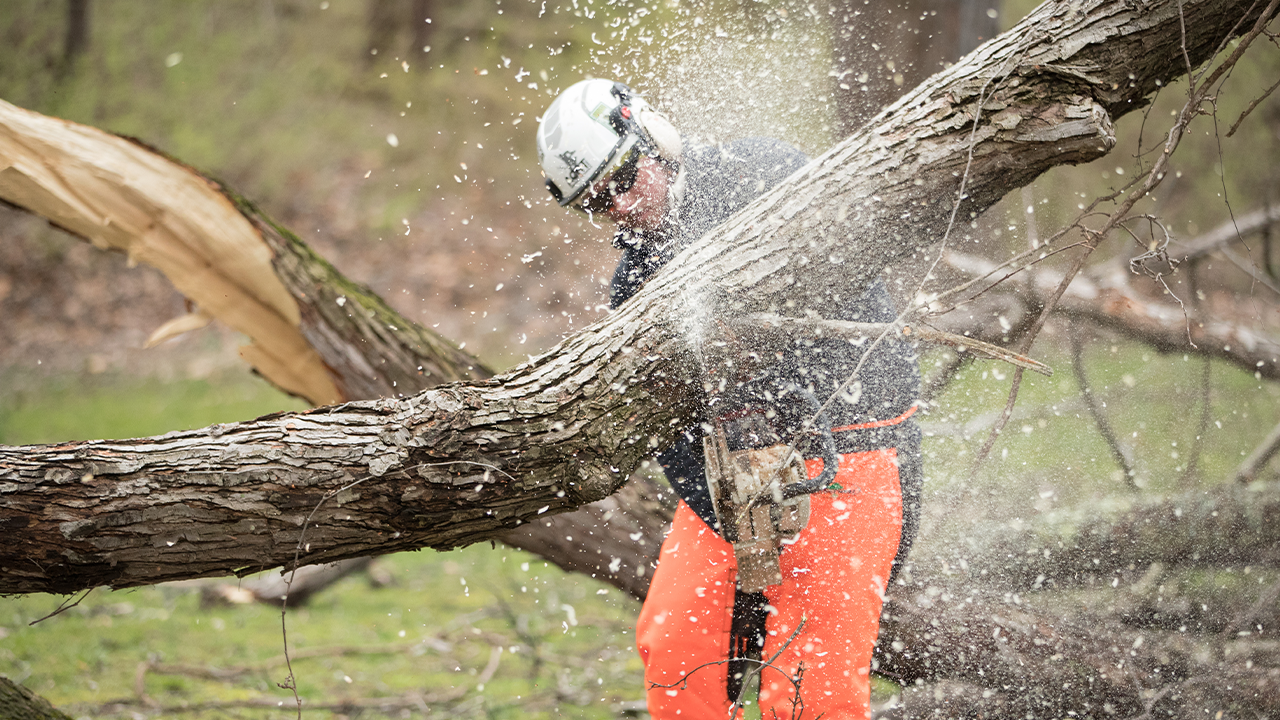 By Kevin Myers, arborist training instructor, ACRT Arborist Training
By Kevin Myers, arborist training instructor, ACRT Arborist Training
For many arborists, a chainsaw is an everyday tool. With such regular, frequent use, it can be easy to slip into complacency. Knowing and understanding chainsaw kickback can help prevent incidents or injuries.
No matter how long you’ve been in the industry, remembering and following safety best management practices in your day-to-day work can be one of the most important things you accomplish every day. For many who are involved in this industry, there’s an inherent element of risk – but we can mitigate that risk by staying on top of established safety guidelines.
For those who regularly work with chainsaws, kickback is potentially one of the most dangerous and devastating safety hazards we may encounter. The sudden, unexpected, and forceful movement – kick – of an operating chain saw can cause serious injury to an unprepared operator. And it can happen to even the most skilled chain saw user.
None of this is new – kickback is widely understood and just about every regular chain saw user is aware of it. So why do incidents continue to occur? What can we be doing to prevent kickback incidents?
It starts with an understanding of kickback and what causes it to occur – and ends with always remaining vigilant when it comes to safe chain saw operation and maintenance.
Understanding kickback
Any chainsaw is a powerful piece of equipment. No matter the size of the individual saw, significant force and power keep the cutting chain rotating at high speeds to efficiently cut through wood.
Throughout the operation, that force that keeps the chain moving is acting just the same on the body of the saw as it is on the chain itself. With an operator holding the body of the saw steady, the force causes the chain to rotate as intended. But when the chain’s rotation is suddenly halted, all that force has to go somewhere, and the momentum is transferred, forcing the saw to pivot up and back toward the operator. This is commonly known as a rotational kickback.
That sudden, split-second halt is usually caused by a cutter tooth of the chain being exposed to a larger bite of wood as it passes the upper quadrant of the guide bar’s tip, or when it comes in contact with a foreign object.
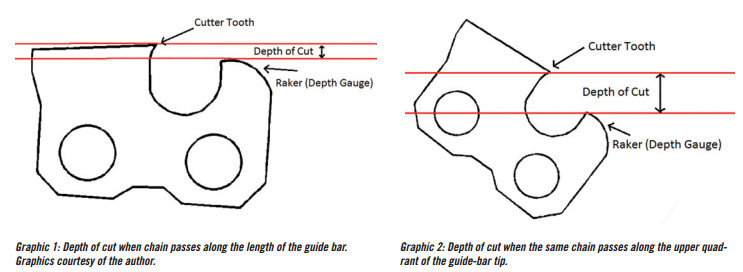
Why does this happen? Under ordinary circumstances, the saw chain very quickly shaves many thin strips of wood out of a cut. Think of a bench planer, if you’re familiar, which is generally used to remove a thin top layer of a piece of wood; a saw chain operates similarly, but far more rapidly. Those thin cuts are critical here.
The depth of each cut made by the saw chain is determined by the raker or depth gauge. The raker passes across the top of the existing cut, or wood surface, and determines the thickness of the material being shaved off by the leading edge of the cutter tooth.
Depending on the manufacturer of the chain and the type of wood being cut, the depth-gauge setting can range from approximately 0.018 inches to 0.030 inches – and this depth is maintained throughout the length of the guide bar. But in the upper quadrant of that bar’s tip – also known as the kickback zone – the chain strikes wood at an angle, dropping the raker below the cutting tooth as it passes, causing more wood to be exposed to the cutter tooth. When that happens, it can cause the tooth to suddenly, momentarily stop, transferring that momentum into a potential kickback event.
Limiting kickback and injury
While there are advanced cutting methods such as bore cutting that involve intentionally sticking the tip of the bar into a piece of wood or tree, kickback most often occurs when that upper quadrant comes into contact with wood or other material unintentionally. While bucking a large log, for instance, an operator may unintentionally strike a branch or another log behind his target with the tip of the bar, which may result in a kickback.
With that understood, prevention is a matter of knowing when, where, and how you’re cutting to reduce the likelihood of unintentional contact with the kickback zone. But it’s also a matter of knowing how to prepare and handle yourself – and your saw – to reduce the likelihood of kickback-related injury.
Much of that depends on proper technique and paying attention at all times to how, where, and what you’re cutting. Know where the tip of the bar is at all times during operation. Pay attention to what is on the opposite side of the wood you’re cutting. Always be mindful of the potential for hidden objects that can cause kickback.
Proper form when holding and operating the chain saw is also critically important. Per the ANSI Z133 Safety Standard, “A chain saw shall be operated with the left hand and thumb gripped firmly around the forward handle and the right hand and thumb gripped firmly around the rear handle,” unless doing so poses a greater threat than doing otherwise. Another good practice here is to lock the left arm during the operation so as not to form a pivot point at the elbow. The standard further states that the operator must be in a stable body position before beginning a cut.
Safety devices, maintenance, and inspection
Many modern chain saws have incorporated enhanced safety measures such as protective coverings for the entirety of the bar tip, low-kickback or reduced-kickback chains, and chain brakes.
The chain brake is one of the most important safety implements on the chain saw. The chain brake stops the movement of the saw’s cutting chain and is often used to prevent the accidental acceleration of the chain when carrying the saw or switching cutting positions. Most saws are equipped with two types of braking systems, a mechanical braking system and an inertia braking system. Some saw manufacturers are now offering a third braking option such as Husqvarna’s TrioBrake™, which employs a second mechanical brake at the rear of the saw, and STIHL’s Quickstop® Plus feature, where the brake engages when your right hand is removed from the rear handle of the saw. During a kickback event, the chain brake can be employed to stop a rotating chain – and though being struck by a static chain is no picnic, it’s far better than being struck by a chain moving at full speed.
Critically, it takes regular inspection and maintenance to ensure that all these safety devices are in proper working order. Always follow manufacturer recommendations through all aspects of equipment care, paying particular attention to the functionality of your safety devices.
Always remain vigilant
Like many safety hazards in our industry, chain saw kickback tends to occur during moments of complacency and when we least expect it. Adherence to best management practices on the job will limit incidents or injuries. It’s important to always remain attentive to the little details that make our jobs go smoothly each day.
This article was originally published in Landscape Business.
Related Articles
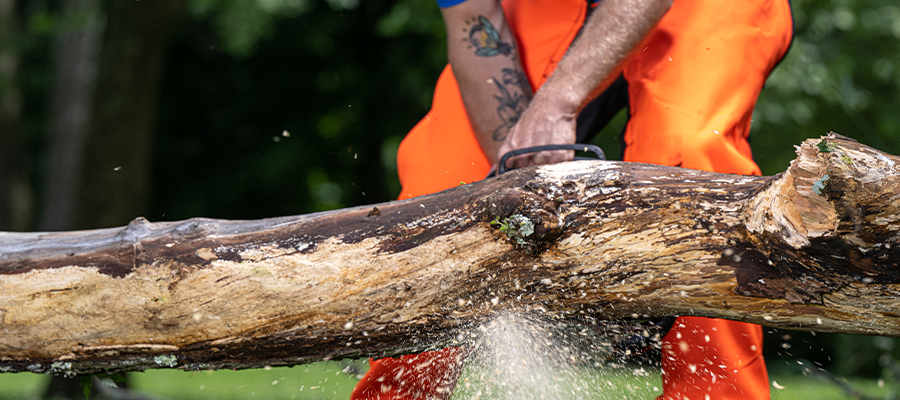
Imagine this: a storm hits overnight. By morning, trees are tangled in power lines, and the call goes out. Your line crews need to be more than ready — they need to be trained, confident, and equipped for the task. Whether your team is routinely trimming vegetation or responding to storm-related obstructions, ACRT Arborist Training’s[...]
Read More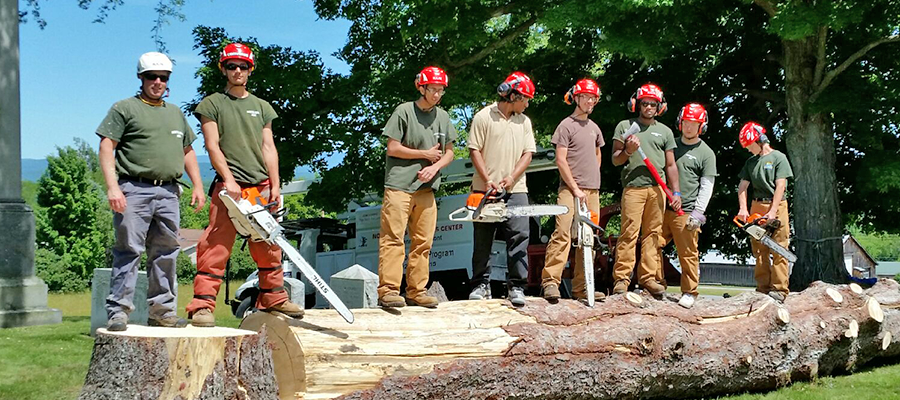
By Jeremy Riemersma, Training Instructor, ACRT As Job Corps marks its 60th anniversary in 2024, it’s a momentous occasion to reflect on the incredible journey of transforming the lives of countless young individuals. As an urban forestry instructor at Northland Job Corps, I have witnessed firsthand the profound impact this program has had on students,[...]
Read More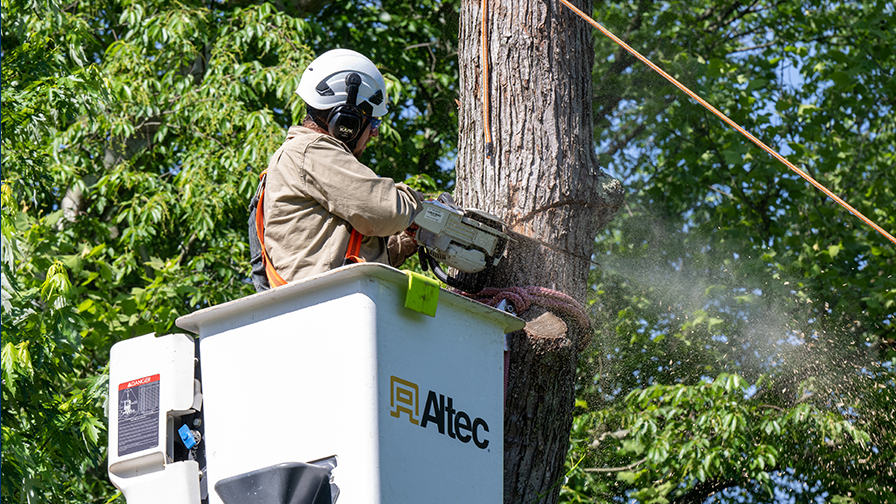
Prolonged use of equipment that emits noise levels above 85 decibels (dB) can cause permanent hearing damage, so it’s crucial that everyone uses proper hearing protection.
Read More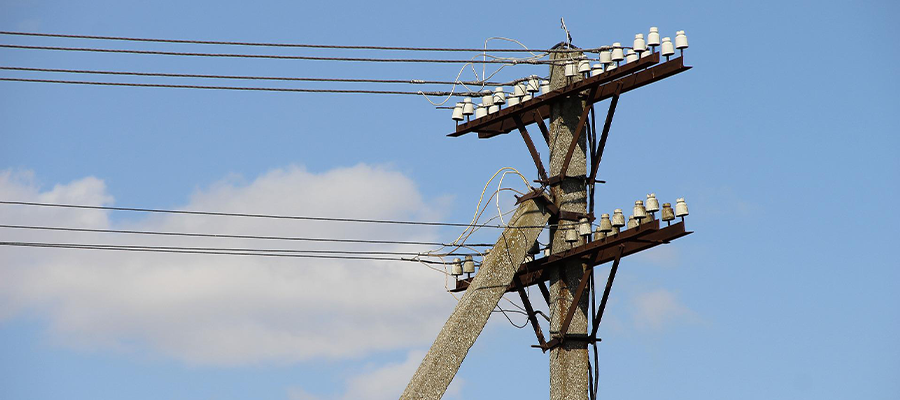
Step and touch potential refer to types of electrical hazards that can cause electrical shock injuries or electrocution. It’s crucial to consider the dangers of these hazards and take steps to prevent them from becoming emergencies. Even if you do not touch a downed power line, you can still be electrocuted or suffer an[...]
Read MoreSUBSCRIBE
Subscribe to our mailing list to receive updates.
Categories
Recent Posts
- How-To: Learning Knot Basics 02th Aug 2018
- How-To: Tying a Stopper knot 07th Aug 2018
- How-To: Selecting the Right Safety Vest 21th Aug 2018
- How-To: Tying a Slip Knot 04th Sep 2018
- How-To: Inspecting Your Snaps 18th Sep 2018
Training the Next Generation
All our classes are built on industry safety practices. Ready to start learning?